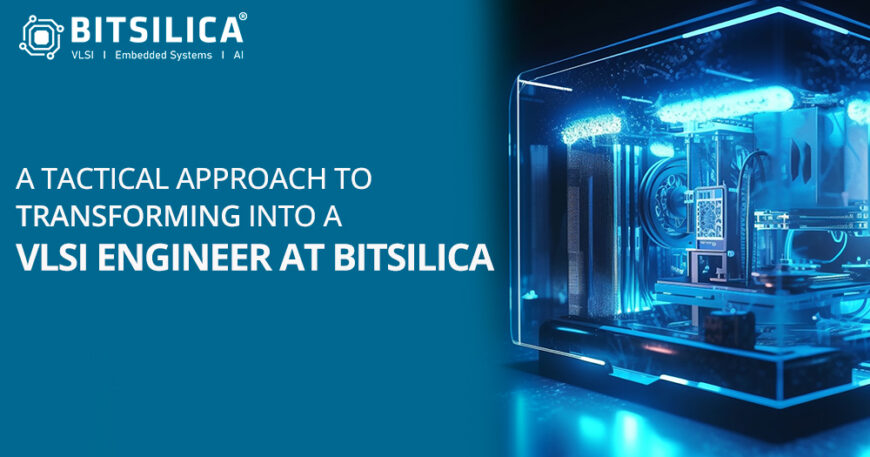A Tactical Approach To Transforming Into A VLSI Engineer At BITSILICA
Embark on a journey into the captivating realm of VLSI engineering, where innovation and ingenuity converge to shape the future of technology. As you set foot on this path, envision yourself as an architect of tomorrow’s electronic landscape, equipped with the knowledge, skills, and determination to navigate the intricate complexities of semiconductor design. This strategic roadmap will serve as your guide, illuminating the pathways to success and empowering you to realize your full potential in the dynamic world of VLSI engineering.
Educational Foundation:
A robust educational background forms the cornerstone of success in VLSI engineering. Pursuing a bachelor’s or master’s degree in Electronics/Electrical Engineering lays the groundwork for your journey. Immerse yourself in specialized coursework covering VLSI design, digital systems, testing methodologies, and computer architecture. This comprehensive education provides a solid foundation for the challenges ahead.
Logical Thinking:
In the intricate world of VLSI engineering, logical thinking is indispensable. Cultivating this skill enables engineers to dissect complex problems, pinpoint root causes, and craft effective solutions. Logical thinking serves as the bedrock of innovation and optimization, ensuring a systematic approach to challenges encountered throughout the design process.
Technical Proficiency:
Technical prowess is paramount for success in VLSI engineering. Forge a robust foundation in digital design concepts, encompassing combinational and sequential logic, synchronous/asynchronous design, finite state machines, and ASIC/FPGA architectures. Master hardware description languages (HDLs) like Verilog and SystemVerilog, showcasing your expertise on platforms like GitHub. Navigate the full ASIC/FPGA design flow, from front-end design entry to back-end physical implementation processes.
Programming Skills & Tool Proficiency:
Elevate your programming skills to excel in VLSI engineering. Proficiency in scripting languages such as TCL, Python, or Perl is crucial for automation and data processing tasks. Gain hands-on experience with industry-standard tools from leading companies like Synopsys, Cadence, and Mentor Graphics/Siemens EDA. Familiarize yourself with UNIX basics and C programming to enhance your versatility in the field.
Soft Skills for Success:
In the collaborative environment of VLSI engineering, soft skills play a pivotal role in ensuring effective communication and teamwork. Cultivate good communication skills and maintain a positive attitude to foster a vibrant work environment. Tailor your resume to highlight relevant experiences, projects, and internships, showcasing your technical acumen and interpersonal skills.
Networking & Continuous Learning:
Stay ahead of the curve by actively participating in industry conferences, workshops, and webinars. Network with professionals in the VLSI field, join online forums, and create an online portfolio on LinkedIn to showcase your achievements and expertise. Continuous learning is essential for success in the ever-evolving landscape of semiconductor design, ensuring you remain abreast of the latest advancements and technologies.
Specialized Focus for Roles:
Tailor your journey based on your desired role within the VLSI domain.
RTL Design Engineers:
Dive deep into synchronous design practices and master efficient data path and control unit design.
Design Verification Engineers:
Explore Universal Verification Methodology (UVM) and protocols to ensure the correctness of your designs.
DFT Engineers:
Embrace concepts such as Scan chains, test points, JTAG, Built-In Self-Test (BIST), and Automatic Test Pattern Generation (ATPG) tools for comprehensive design-for-testability solutions.
Post Silicon Validation Engineers:
Master bring-up procedures, validation plans, Silicon Architecture, Emulation, and FPGA Prototyping to ensure the functionality and reliability of silicon devices.
Physical Design Engineers:
Acquire proficiency in Clock Tree Synthesis (CTS), timing closure, power optimization, floorplanning, placement, and routing to ensure optimal physical implementation of designs.
As we conclude this exploration of the strategic path to VLSI excellence, remember that your journey is just beginning. Armed with a solid educational foundation, technical proficiency, and soft skills for success, you are poised to make a significant impact in the semiconductor industry. Embrace each challenge as an opportunity for growth, and never lose sight of your aspirations. With determination, perseverance, and a commitment to continuous learning, you have the power to shape the future of VLSI engineering and leave an indelible mark on the world of technology. Bon voyage on your VLSI odyssey, and may your endeavors be met with boundless success and fulfillment.
Key Phrases: VLSI Engineering
Explore More: VLSI Design Verification Challenges Lets Dive Into Technical Insights





